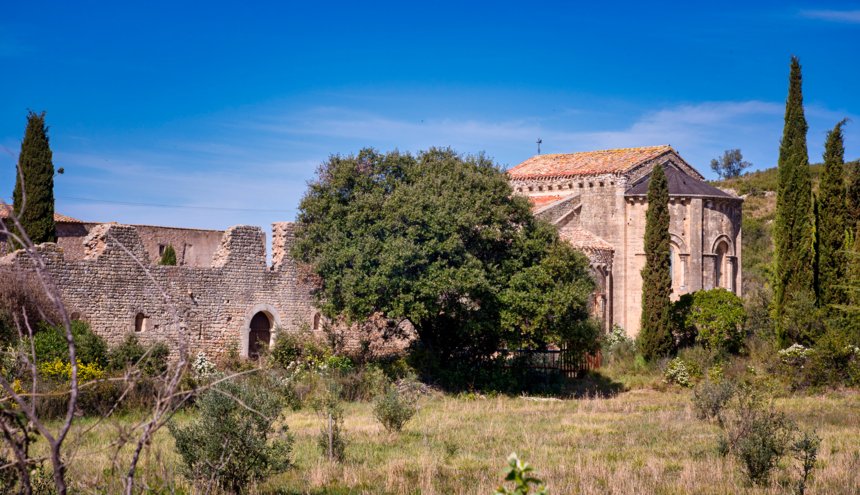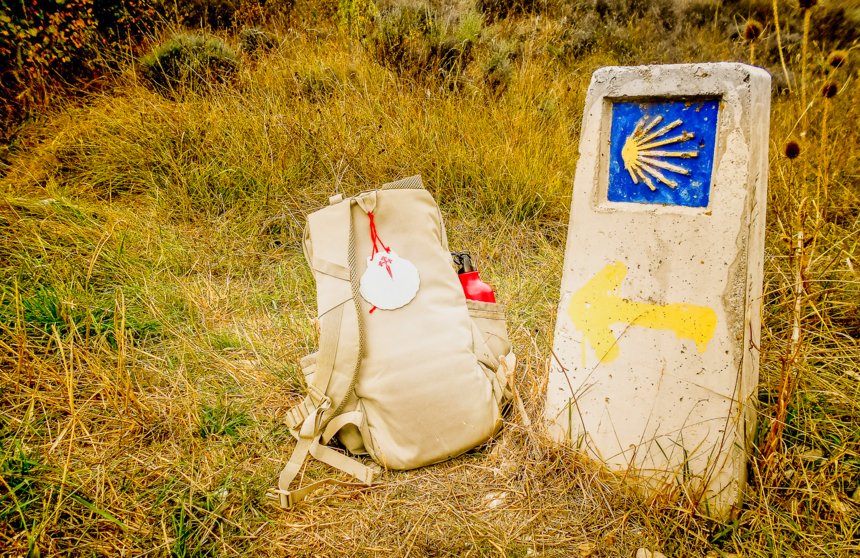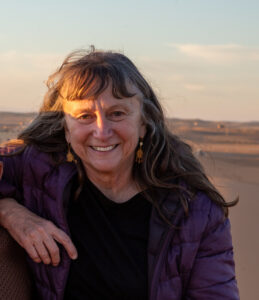By Ava Kabouchy – Photography & Travel Website
There’s perhaps no pilgrim trail more famous than the Camino de Santiago, the Way of St James in the north of Spain. Hundreds of thousands of people hike it every year. Still, every pilgrimage is unique. No walk will look exactly like another. Besides the external factors, such as season, weather and temperature, the cultural factors like fiestas, holidays and availability will alter your travel. Much more will the people you meet on your journey define your camino. And then there’s the starring role: You. How you struggle through the obstacles on your way. How your body and mind cope with both past and present sufferings.
Follow Ava Kabouchy on her journey to Compostela and learn how she found blisters, angels and new friends along the way.
The seed was planted that day

Looking online where my friend, Charles, and I might take a day trip from Beziers, France, I found the Abbaye de St. Marie de Fontchaude, a short distance away in a hamlet surrounded by vineyards. Way off the tourist trail, the church and abbey were unlocked for us by the caretaker. The small statues in the chapel were covered with a dark red cloth as this was the season of Lent. We were the only visitors and enjoyed the solitude of such a setting, a well preserved 12th century Roman church, standing arches and tumbled arches in the garden. Outside I noticed a stone fountain with water dripping from the brass faucet, and into the stone a scallop shell had been carved. The fountain was for pilgrims in need in water centuries ago and now. “Charles,” I said, “we are on the Camino de Santiago.” That afternoon I was already making plans in my mind for my own pilgrimage.
Arriving in St. Jean Pied de Port
 Four months later, I got off the train in St. Jean Pied de Port, the starting point of the Camino on the French side of the Pyrenees, ending in Santiago de Compostela, 594 kms/370 miles away in Spain. October weather prevented me from doing any more than 254km/158 miles, but as was often repeated to me by other pilgrims, “This is your Camino. You do it as you want.” Prepared with a light backpack, hiking poles, comfortable walking shoes, various light sources, a guidebook, ecological soap, a quick dry towel, a pair of gloves, hiking pants and shirts, a camera, notebook, a phone with no GPS, a map from the guidebook, and a lightweight Eddie Bauer jacket, I headed towards the pilgrim inn where I would spend the night.
Four months later, I got off the train in St. Jean Pied de Port, the starting point of the Camino on the French side of the Pyrenees, ending in Santiago de Compostela, 594 kms/370 miles away in Spain. October weather prevented me from doing any more than 254km/158 miles, but as was often repeated to me by other pilgrims, “This is your Camino. You do it as you want.” Prepared with a light backpack, hiking poles, comfortable walking shoes, various light sources, a guidebook, ecological soap, a quick dry towel, a pair of gloves, hiking pants and shirts, a camera, notebook, a phone with no GPS, a map from the guidebook, and a lightweight Eddie Bauer jacket, I headed towards the pilgrim inn where I would spend the night.
Early the next morning, I went to the Camino office to get my pilgrim passport, which would be stamped along the way to prove that I had walked the required number of kilometres to receive my pilgrim certificate in Compostela. I also made arrangements to have my backpack transported to the monastery at Roncesvalles, Spain, on the other side of the Pyrenees, where I would spend the night. This transport service is one that many pilgrims use to literally lighten the load during the day and then find their packs waiting for them at an inn or monastery where they had made reservations for the night.
Crossing the Pyrenees

The weather was clear and sunny upon my arrival at St. Jean Pied de Port, but it changed overnight. Cooler temps, fog, and sometimes a light drizzle accompanied those beginning their pilgrimage that day, which meant crossing the Pyrenees on foot in less than ideal conditions, I made a stop, as many do, at Orisson, 7.6 km into the mountains to fill my water bottles, have a hot cup of tea, and enjoy a delicious, hot bowl of soup, needed on such a day.
The ascent to the summit was difficult. My pheromones were in full swing, however, thinking about what I had just accomplished, but having no idea that the descent would be so much worse. It wasn’t really a descent. Too often it was an ascent before a descent and then another ascent. The fog rolled in, then the rain, not a heavy rain, but enough to make walking uncomfortable. I had a plastic raincoat in my bag, so I was able to keep my backpack and most of me dry.
Up ahead of me I saw a couple, and I was happy to have others within sight. At one point I caught up with them and found they were Castilian Spanish. I walked on a head a little, but at some point, the scallop shell marker sent me off the road, then around a fence in the mud. I waited for the Spanish couple, and the woman could see I was waiting for them. “Tranquilo, Señora, tranquilo.” Being tranquilo when we seemed to be lost and there was no one to help us was not easy. We made another detour by following the scallop markers, and I walked on ahead. There was a small stone house, a refuge for the pilgrims; two others came in and then the Spanish couple. I wanted to take out my trail mix and share it, but my fingers were so cold, I couldn’t use them and asked one of the others to unzip my daypack. Up and down more hills, my shoes covered in mud, I was cold but had no choice but to continue.
I came to a road, which led to a forest, foggy and beautiful, and at some point I managed to take out my camera. I was a good distance ahead of the Spanish couple at that point and just kept going down. At some point two men appeared, and I said to them in Spanish: “He estado caminando y caminando, pero no puedo salir!” “I have been walking and walking, but I can’t get out!” “Trente minutos, más or menos” was the answer; “Thirty minutes more or less”, and not long after, I saw the welcome sight of the monastery. It had taken me 11 hours and 16 difficult miles to get there. Once again I heard, “Tranquilo, Señora”, this time from a pilgrim helper. She got me settled in, I got my Camino passport stamped, and found a room with 59 other pilgrims. I showered, skipped dinner, and got into bed at 8:30, exhausted by exhilarated that I had just crossed the Pyrenees on foot.
Tramposa: Cheater – A new Spanish vocabulary word

The next morning I became a tramposa, a cheater, because I booked a room in a hotel, went there by taxi and took a day of rest. Tramposa still, I took the bus to Pamplona, but not before meeting, once again, the Spanish couple. They stayed in the same town, but had hiked to Pamplona, and laughed about meeting again as we did. It’s so much about the people you meet.
Upon arriving in Pamplona, I walked with a young Irish woman, and together we found the albergue, a pilgrim inn. I checked in and just walked around Pamplona, getting used to this new experience and thinking about where I was. We later met for lunch with other pilgrims on the square in front of the inn, and one said that since we had finished eating, he would show us photos on his phone of his feet covered in painful blisters. I had heard of this happening, that pilgrims sometimes had to take a couple of days off to heal their feet. This man’s feet were not a pretty sight.
Conversation with a Catholic priest

On my way from Pamplona to Uterga, (no bus this time) my next destination, I walked with a man who turned out to be an Australian Catholic priest. He told me was walking the Camino to strengthen his faith. I felt at ease talking with him about my Roman Catholic upbringing, which I still view with dismay – beliefs reinforced by guilt and fear of punishment. Certainly, practices and beliefs have changed, but in my youth, girls couldn’t go past the altar railing, and memorizing the catechism was considered learning. The fear of spending eternity in hell for eating meat on Friday or not going to church on Sunday were among the many fears in our young Catholic lives.
Our discussion, however, actually made me consider going back to the Catholic church, but I gave up that idea when I told him about having communion in Assisi, Italy, that I was so moved by the service, the chanting, the incense, and just the familiarity of it all. He asked me if I had gone to confession before, which I hadn’t, and he said that I should have. I wondered what I could possibly confess at that point in my life, but my conversation with him, nonetheless, made me appreciate how strong his faith was.
I needed a break from our fast walking after about 90 minutes, and in parting I told him of my belief in angels, how on the night when my second grandchild was being born, I drove a new route to my daughter’s house at night, and I just knew that the car in front of me was leading me there, and it did. I told Fr. Michael that I will think of him as an angel, too, and my eyes welled a little. Such a meaningful conversation and I had only been on the Camino a short time.
Communal Dinners and Conversations

Next stop was in Uterga where I had dinner with Angry Hanna, as I called her in my mind. Hannah had started her pilgrimage at Le Puy en Velay in France, intending to end in Compostela (1,515 kms/941 miles) to make peace with God, but she didn’t explain what she meant. Hanna was edgy, spoke little, and then just left as soon as she finished dinner. Two Israeli women hiking just a short part of the Camino were also at dinner, both of whom laughed and called Donald Trump their friend. I thought it best not to make any remarks. I also met Alice, a Brazilian woman about sixty years old. She was in the bunk across from mine, and had badly hurt her knee and could not walk.
I know how it feels to be sick and alone and not in one’s country, so I stayed with her and used what remained of my knowledge of Spanish, and she answered in Portuguese, and I got most of what she was saying. In my backpack were a few St. Francis crosses, called Tau, which he designed as a sign of conversion from the wild times of his youth to a man who helped the poor and reminded others not to think only of themselves. Alice cried when I gave a Tau to her and then she sang two songs to me in Portuguese about St. Francis. It was a touching moment for me, a reminder of the strong beliefs in God that some people on the Camino carry with them. Alice and I still keep in touch and she reminds me of her invitation to visit her in Brazil.
A day of rest is suggested for the pilgrims and I took mine in a small hotel and headed the following day to Puente la Reina, the Queen’s Bridge. I stayed in an albergue in a room with four talkative young women, whose conversation I greatly enjoyed – sharing their plans for the future and taking time now to walk part of the Camino. The main street of Puente la Reina is bordered by churches, shops, small restaurants, and cafés all built of stone and leads to the six-arched Romanesque bridge.
Why many thousands of pilgrims, perhaps millions, crossed that bridge I was beginning to understand – strengthen their religious faith, make peace with God, give thanks, or maybe all three.
֍ ֍ ֍
Check out what happens then in Part II of Ava’s Camino conquest!
About Ava Kabouchy
 As a child, Ava was fascinated by world maps, which later turned into travels to many parts of the world. She has worked in several African countries, created a microcredit group for women in Honduras, and did a volunteer photography gig for a clinic for a Mayan community in a remote mountainous region of Guatemala. Recently, she hiked along the Camino de Santiago in Spain and in France, travelled in Morocco, fulfilling a childhood dream of walking barefoot in the Sahara and another of seeing the aurora borealis in Iceland.
As a child, Ava was fascinated by world maps, which later turned into travels to many parts of the world. She has worked in several African countries, created a microcredit group for women in Honduras, and did a volunteer photography gig for a clinic for a Mayan community in a remote mountainous region of Guatemala. Recently, she hiked along the Camino de Santiago in Spain and in France, travelled in Morocco, fulfilling a childhood dream of walking barefoot in the Sahara and another of seeing the aurora borealis in Iceland.
Ava is the author of the recently published “Where in the World is Grammie Now?”, a book for young readers to teach them about Saudi Arabia, a country not often studied in middle school curricula. She has also authored a book on her four years in Saudi Arabia: “Wanderlust, A New Lease on Life in the Kingdom of Saudi Arabia”.
Ava makes her home in southwest France and on a remote island off the coast of Maine, USA.
Learn more about Ava’s adventures on her Photography & Travel Website
More info
- Camino de Santiago official website
- Santiago de Compostela’s Pilgrim Office
- Camino de Santiago on Wikipedia


